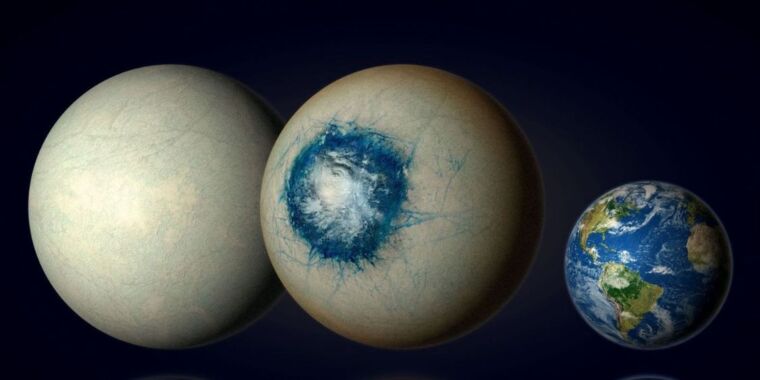Of all the potential super-Earths – terrestrial exoplanets with a larger mass than Earth – an exoplanet orbiting a star just 40 light-years away from Earth in the constellation Cetus may be the most Earth-like planet discovered yet.
The exoplanet LHS 1140 b was thought to be a mini-Neptune when it was first discovered by NASA’s James Webb Space Telescope in late 2023. After analyzing those observational data, a research team led by astronomer Charles Cadieu of the University of Montreal suggests that LHS 1140 b is likely a super-Earth.
If the planet is a version of Earth, its relative proximity to its cold red dwarf star means it’s likely a giant snowball or mostly frozen body with a substellar (closest to the star) ocean that looks like a cosmic eyeball. It is currently thought to be the exoplanet most likely to have liquid water on its surface, and may even be habitable.
Cadieux and his team said: [nitrogen]A dominant atmosphere exists on the “super-Earth” of a habitable super-Earth. study It was recently published in The Astrophysical Journal Letters.
Sorry, Neptune…
Two passes of LHS 1140 b were observed in December 2023 by the NIRISS (Near-Infrared Imager and Slitless Spectrograph) instrument aboard Webb. NIRISS specializes in detecting exoplanets, revealing their details through transit spectroscopy. Transit spectroscopy captures light from an orbiting planet’s host star as it passes through the planet’s atmosphere and toward Earth. By analyzing different spectral bands of that light, scientists can learn about specific atoms and molecules present in the planet’s atmosphere.
To test their previous hypothesis that LHS 1140 b is a mini-Neptune, the researchers created a 3D Global Climate Model (GCM), which used complex mathematics to explore the different combinations of elements that make up the planet’s climate system, including land, oceans, ice, and atmosphere. Several different GCMs of mini-Neptune were compared to the light spectrum observed with transit spectroscopy. Models of mini-Neptune typically focus on gas giants with thick, hydrogen-dominated, cloud-free or nearly cloud-free atmospheres, but the spectral bands in this model did not match the NIRISS observations.
With the possibility of a mini-Neptune all but ruled out (though further observations and analysis are needed to confirm this), Cadiu and his team turned to another possibility: a super-Earth.
Earth away from Earth?
The spectrum observed by NIRISS was more consistent with the GCMs for super-Earths, which are typically composed of a thick nitrogen or CO2An air-rich atmosphere with some form of water present in ice or liquid form enveloping the rocky surface.
Models also suggest the existence of a secondary atmosphere, which forms after the escape of the original atmosphere of light elements (hydrogen and helium) during the early stages of a planet’s formation. The secondary atmosphere forms from heavier elements released from the crust, such as water vapor, carbon dioxide, and methane. Secondary atmospheres are usually found on warm terrestrial planets (Earth has a secondary atmosphere).
The most significant of the Webb/NIRISS data that didn’t match the GCMs is that the planet’s density is lower than expected for a rocky planet (based on its size and mass measurements), which is consistent with an aquatic planet with about 10-20 percent of its mass being water. Based on this estimate, the researchers believe LHS 1140 b may even be a hythean planet – an ocean planet with most of the properties of a super-Earth, but with an atmosphere dominated by hydrogen instead of nitrogen.
Because the planet orbits a tidally locked star, some models suggest that it is a mostly icy planet with a substellar liquid ocean on its dayside.
LHS 1140 b may be a super-Earth, but the Hysean planet hypothesis may be ultimately rejected. Hysean planets are susceptible to the runaway greenhouse effect, which occurs when enough greenhouse gases build up in a planet’s atmosphere and prevent heat from escaping. On planets that cannot cool, liquid water will eventually evaporate.
We’re getting closer to understanding what kind of planet LHS 1140 b is and whether it’s habitable, but more observations are needed. Cadiu hopes to continue this research by comparing the NIRISS data with data from other super-Earths previously collected with Webb’s Near-Infrared Spectrometer (NIRSpec). At least three flyby observations of the planet with Webb’s MIRI (mid-infrared) instrument are needed to make sure the star’s radiation isn’t interfering with observations of the planet itself.
“Due to the limited visibility of LHS 1140b, several years of observations may be required to detect a potential secondary atmosphere,” the researchers wrote in the same paper. study.
So is this planet really a frozen exoplanet? This mystery will likely continue for years to come.
Astrophysical Journal Letters, 2024. DOI: 10.3847/2041-8213/ad5afa


